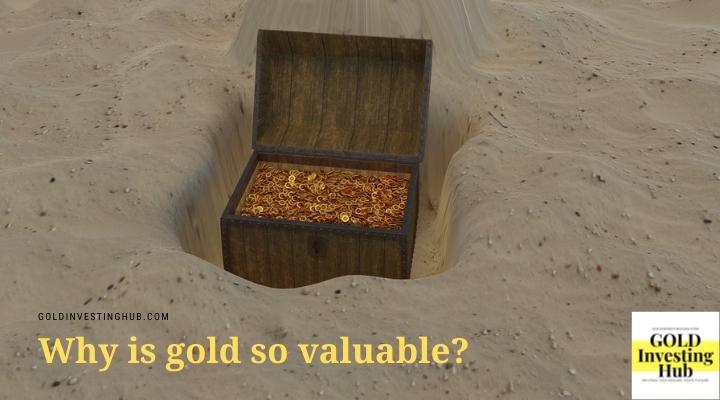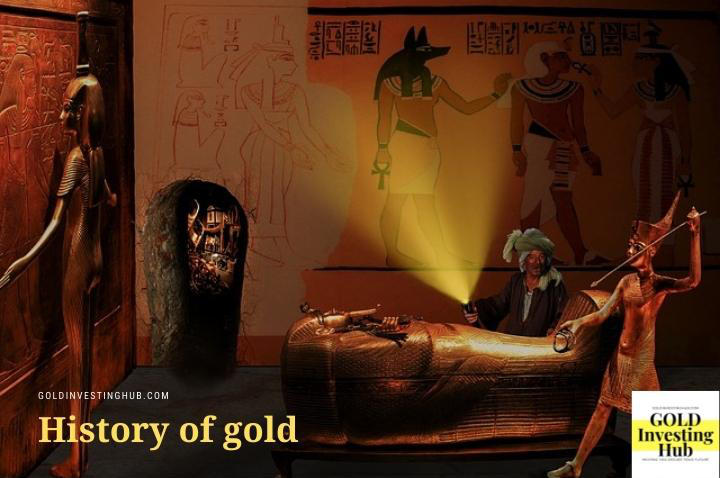Few metals in history can claim the same level of desirableness as gold. Why is gold valuable? Here are 3 reasons gold has maintained high value throughout history.
Contents
While gold will last untarnished and unmodified for thousands of years, silver does have a low degree of reactivity and even has a propensity to tarnish.
Despite being fairly soft and exceedingly bright, it is generally one of the most expensive and significant metals humanity has ever utilized.

What precisely made gold so expensive and desirable, and why did so many individuals exhibit such interest in coining it?
Surprisingly, what makes gold special is not so much what it can accomplish, as what it can do that other elements can't. (It also helps that it is attractive and shiny.)
But that’s not all. So let’s take a look at the timeline of gold and how it led to all that we know about the value of gold in the past and today.
As early as 7,000 years ago, gold was utilized by the ancient civilizations of Egypt and Rome.
In addition, nations who arrived in Central America and South America and built impressive civilizations like the Maya, Toltec, and Incas continued to revere gold throughout history.
In ceremonial rites like sacrifices or coronations, these civilizations respected gold's supernatural power and adored it for its beauty.
These civilizations used gold as money (gold coins), which aided in their economic and cultural development.

The discovery of South America's large gold reserves in the 16th century caused a significant decline in the value of gold, which in turn caused a significant rise in the price of everything else.
Since then, the issue has often been the opposite: an excessively fixed gold supply. By decoupling their currencies from the Gold Standard, for instance, several nations were able to avoid the Great Depression of the 1930s.
They were able to reflate their economies by printing more money as a result of this.
With a fixed supply, the demand for gold can fluctuate greatly, which can cause price fluctuations that are just as erratic.
Gold is still a useful but not perfect medium for an economy, as history has demonstrated. There is only a finite quantity of gold that is realistically available to humans on Earth, despite the fact that it is sturdy and rare enough to be used as a stand-in for value.
While your economy is modest, everything will be OK, but soon you will mine out all the gold. When you run out of money to meet demand, you get deflation (price drops), the economy stalls, and riots break out.
Over thousands of years, society has progressively been accustomed to thinking of gold as having worth.
Due to its significance in creating the world's first coins, gold played a crucial part in the development of the world's currency markets for many centuries, up until around half a century ago.
Precious metals were the ideal choice for early payment systems since they could be transferred between dealers and merchants.
As a result, things could be transferred in theory without having to be delivered right away and served as a mutually acknowledged and immediately comparable on a like-for-like basis unit of exchange.
Now, let’s understand gold even better by getting into a few scientific properties and how it is used in things we use or wear today!
When compared to other metals, gold is different in that it is resilient and soft to the touch. It also boasts certain unique features, most notably its indestructibility.
Since it is chemically inert, it is anti-corrosive and durable enough to last for a very long time without changing.
Around the world, gold, with the chemical symbol Au, is found in alluvial deposits and mineral veins and is frequently created as a byproduct of other metals like copper and lead (although there are many large mines primarily producing gold).
The average mass of the atom in gold is 196.96. Its density is 19.3 grams per cubic centimeter, its melting point is 1,947.7 degrees Fahrenheit, and its boiling point is 5,162 degrees Fahrenheit.
Many individuals invest in gold nowadays because of its worth. When they are worried about the economy or the stock market, or if they just want to protect themselves against inflation, investors purchase gold.

We will get into investments in a minute but let’s continue understanding gold first.
Due to its eternal qualities, gold requires supernatural powers to produce.
According to theories, all of the gold that has ever been recovered was not produced on Earth but rather came from neutron star collisions or supernova explosions.
Both thermally and electrically, it is an excellent conductor. It is malleable enough to be distributed into thin sheets without splitting and ductile enough to be stretched without breaking.
Gold has four main markets: it is used to make jewelry, it is a component of technology, it is kept by central banks, and it is exchanged by investors.
Approximately half of all gold is used to make jewelry. The current center for gold jewelry is in the East, with China and India accounting for up to half of global demand.
It is used in dentistry, medicine, manufacturing, electronics, and the arts. It even aids in crime-solving: Researchers who support police have created a method to use gold to identify fingerprints on materials like leather or plastic.
Gold isn't typically just sitting around ready to be picked up, though. Gold may be discovered in deposits that are buried in rocks and other minerals, just as other metals.
Gold can occasionally be found in extremely small particles that require a microscope to view.
Sometimes the particles are small flakes that can be seen with the unaided eye and sparkle.
Mine workers must separate the gold from other minerals and rocks, such as quartz or granite, in order to gather these priceless fragments in amounts great enough to be worth something.
For a very long time, people have been looking for efficient ways to harvest gold.
By the way, speaking of harvesting gold and using it, did you know?
To take advantage of gold's reflecting properties, the mirrors of NASA's new James Webb Space Telescope are coated with a super-thin layer of gold!
Now, let’s talk about this metal as an investment.
Unlike foreign exchange or other commodities like oil, which are more vulnerable to market and political variables, gold is not.
Because of this, many people think that gold is better at maintaining its value over longer periods of time, making it appealing for investors looking for a port in a storm during periods of turbulence in the stock, financial, or commodities markets.
Gold prices tend to rise during uncertain times.
Because a large enough number of people think it is valuable and because it possesses a particularly well-balanced combination of beauty, rarity, and durability.
In a few hundred years, gold may be entirely supplanted by something else.
Compared to other metals, gold is more boring and common, yet it commands extremely high prices.
This was less of a problem in the good old days when economies were small, local, moved slowly, produced little, and had little technical capacity.
Even though it was in little supply, gold was the perfect tender due to its durability, rarity, mobility, ability to be verified, and safety in usage.
Because humans lacked the technological foundation to create fake money with such characteristics, we employed a naturally existing material.
Gold is a precious metal that has been used for more than 6,000 years and continues to be mined for a variety of uses today.
Because of the stability of its pricing, it is frequently utilized as an investment. In fact, savvy investors have learned they can rollover gold into an IRA or 401k with the help of a professional. To help, we created a list of gold dealers here and review the best gold IRAs here.